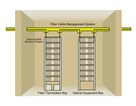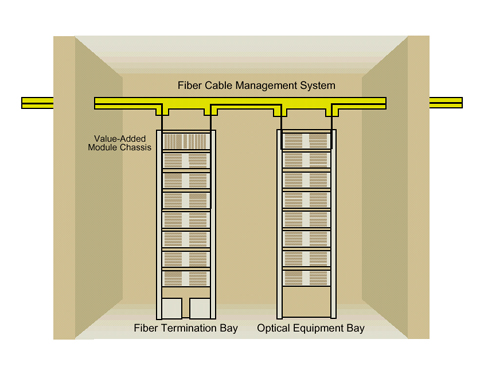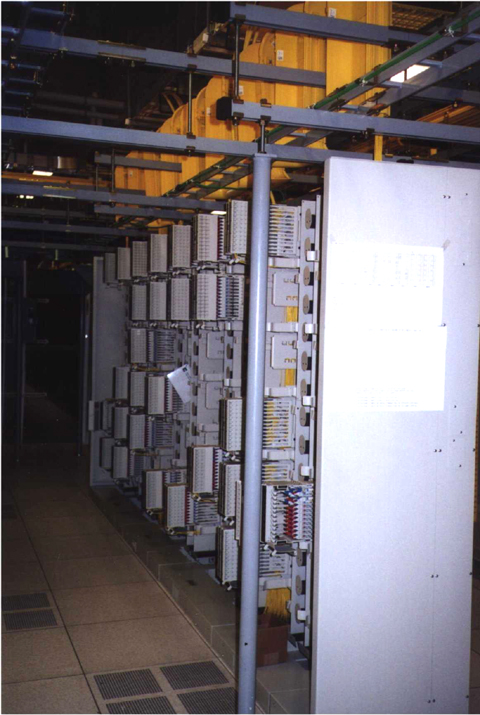Well Planned Fiber Cable Management a Must for Colocation Hotels

TABLE OF CONTENTS
Many Ways to Sell the Space
Fiber Cable Management: One of the Basics
Fiber Frame
Fiber Raceway
Monitoring and Test Access
Window to the Optical Layer
Conclusion
A wide range of organizations, including Internet service providers (ISPs), data CLECs, digital subscriber line (DSL) providers, voice-processing companies and even large corporations needing hot backup sites are seeking ways to share infrastructure to reduce costs and improve service. To serve this burgeoning need, independently owned and operated colocation facilities are springing up across the country. These dwellings provide floor space in a single building for many different flavors of services providers and users to tap into each other's high-speed networks and offer multiple services to customers.
Many Ways to Sell the Space
It's clear that carrier-neutral colocation is rapidly becoming a model for tenants and owners. For tenants, there's no infrastructure to worry about and no streets to dig up, yet they've got a direct connection to a whole range of potential customers. For owners, the demand for space is skyrocketing. But with success comes competition— and large metropolitan areas today may have several colocation facilities competing for business. So, much like a commercial leasing agent, the colocation "hotelier" must be able to showcase services and amenities to attract and retain lucrative tenants.
Though the colocate building exterior may be non-descript and plain (in fact this is desirable from a security standpoint), the interior must be well organized, functional, secure and appealing. From a tenant perspective, it's important to know that the company you're moving in with is competent and committed to the long term. Issues like heightened security, fire suppression, floor loads, redundancy and power needs that far exceed those of a conventional office building must be factored into the design. Even amenities like rest areas and kitchen facilities make a difference when you consider the 24 x 7 requirements for access.

Fiber Cable Management: One of the Basics
Above all, service reliability is paramount, prompting guaranteed QoS (Quality of Service) agreements to be written into many service contracts. There can be some real challenges, however, in backing up this guarantee. There may be service provider cables running through hundreds of thousands of feet of open floor space, entering and exiting hundreds of individual cages.
Planning the cabling infrastructure may require some degree of educated guesswork. Customers will always have unique requirements. An individual tenant might demand all copper or all fiber, or a specified mixture of both to their equipment. Contract periods can be as short as a month, so tenant churn will be an issue. Thus, a design model must be flexible enough to accommodate a mixture of media, scalable to adapt to growth, and reconfigurable on the fly.
Management of the fiber cables in the network has a direct impact on network reliability, availability, performance, and cost. It also affects network maintenance and operations, as well as the ability to reconfigure and expand the network, restore service, and implement new services quickly. The proper fiber cable management system provides the bend radius protection, cable routing paths, cable accessibility and physical protection of the fiber network. If these elements are done right, the fiber network can deliver its full competitive advantages
Fiber Frame
Typically fiber comes from a centralized termination device, usually a fiber frame or panel. The fiber frame is designed as a centralized point for termination, splicing and storing optical fiber. From there the service is routed through a raceway, then dropped off and distributed to the various cages leased by the tenants. The hotel is responsible for the management of the cable and the integrity of the service from the frame or "meet-me room" to the customer cage.
As service options and tenants multiply, hotel owners are finding that their existing fiber frames and troughs are overflowing with large masses of fiber patch cords. Many cable management problems arise from improper routing of these patch cords—causing congestion in the termination panel and the cable ways, increasing the possibility of bend radius violations and long-term failure. Well-defined routing paths, on the other hand, reduce the training time required for technicians and the time required to route and reroute patch cords. In addition, having defined routing paths makes accessing individual fibers much easier, quicker and safer, reducing the time required for reconfigurations or tracing a fiber for rerouting.
Storing of excess fiber jumper cable can also create problems. Since most single mode connectors today are still factory-terminated -- making a patch cord of a predetermined length -- there is usually some excess fiber remaining after the connections have been made. While the predetermination of patch cord length simplifies ordering, reduces inventory and results in overall savings to the customer, these fibers still need to be properly protected to ensure their long-term reliability and that they are not damaged during the day-to-day operations of the network. The stored fibers also need to be easily accessible so that reconfigurations can be performed without disturbing the adjacent fibers. As the physical length of fiber and its potential exposure to damage and bend radius violations are greatest here, the slack storage system is perhaps the most critical element in terms of network reliability and reconfigurability.
Slack storage systems come in many styles and configurations. Many systems involve coiling or wrapping fibers in open troughs or vertical cable ways, which can increase the probability of bend radius violations and can make fiber access more difficult. Tracing and removing fibers through a system where fibers are wrapped and twisted around each other will be more time-consuming and have a higher likelihood of disturbing the adjacent fiber. Accessibility and thus the time to reconfigure the network will be optimal in a system that maintains a continuous non-coiled or non-twisted routing of the jumpers.

Fiber Raceway
In order to provide proper protection and ensure future growth and reconfiguration capabilities, all fibers routed between the fiber frame and the customer cage should be placed in a dedicated troughing system. This troughing system is generally located at the lower level of the auxiliary framing/ ladder racking structure. Locating the troughing system there makes access for installing and rerouting fibers much easier. As the system is located in an area of the office where technician activities are common, the troughing system needs to be durable and robust enough to handle day-to-day activities. Technicians working on installing copper or power cables on the ladder racking can come into contact with the system, for example. If the system is not robust enough to withstand contact with a technician who accidentally puts his weight on the system, the integrity of all the fibers in the troughing system is in jeopardy. A durable, properly configured troughing system with proper cable management, especially bend radius protection, helps improve network reliability and makes network installation and reconfiguration faster and more uniform.
For the initial installation, the traditional method of pre-provisioning downspouts in raceways works well if the optical handoff takes place right over the main distribution frame or some other permanent location. In the colocation hotel, this method is insufficient for several reasons. First, a hotel owner can't predict what type of media a customer may require dropped off at their cage, and certainly cannot pre-determine where within that cage the media should be dropped.
The second issue is speed of deployment. Installing a traditional downspout may take 40 minutes, or longer if it requires rerouting a ladder rack or working with a raceway system that is already carrying active traffic. This is unacceptable in our hurry-up environment. Today's "reusable access" infrastructure must be flexible enough to drop media virtually anywhere in seconds and simple enough remove it equally fast to meet the needs of the next tenant.
A product like ADC's Express Exit 2x2 unit used in conjunction with the FiberGuide raceway system allows quick, easy deployment of fiber to any tenant within the hotel. It also allows the drop to be removed just as easily for the next tenant.
Monitoring and Test Access
It goes without saying that service integrity has become extremely important to all parties. Service guarantees at a higher level (ATM, Frame Relay, IP, Ethernet) are more of a concern than e-mail access. As e-mail and other forms of data services have become critical to individuals and corporate enterprises, any significant signal loss or extended downtime cannot be tolerated. Finding a problem before it becomes a hard failure and affects customers does more than prevent loss of business. It gives the service provider flexibility in choosing the best way and time to address the problem. Thus, many service providers are implementing proactive maintenance practices by using test equipment on every fiber at the demarcation point prior to handoff— ensuring to customers that they are getting the level of service that they have contracted.
But what if trouble does develop? For example, a tenant in one cage suspects it is not receiving a clear signal from their selected service provider. A hotel owner must have a way to look back into the network to see where the problem originates. And to do it in a non-intrusive manner since cost delay and interruption of service while a line is tested intrusively would cause more than a minor inconvenience.
Window to the Optical Layer
VAMs (Value Added Modules), sometimes called splitter modules, are finding tremendous utility at these critical fiber demarcation points. VAM monitoring modules slide into the fiber frame, and fiber patch cords are installed from each to the network equipment. The centralized location allows for quick response to a trouble call. For instance, if a service provider suspects an unclear signal on a particular circuit, they can locate the VAM that connects to that circuit, and then connect the VAM to test equipment to determine the source of the problem. The VAM is equipped with separate ports for local testing. Within each module, each transmit and receive signal passes through a splitter, perhaps a 90/10 split. Ninety percent is allowed to proceed to its destination, while 10 percent is routed to the local monitor port for use by an external test device. This allows local testing of either signal without interruption of service with test devices having access to the full optical signal — exactly what the customer is getting. VAM technology has also been developed to perform these tasks remotely, eliminating the need to dispatch a technician if the problem resides somewhere outside the four walls of the colocation hotel.
Conclusion
Fiber cable management is vital, because it's the one area where all the signals in the fiber network are routed and the one area where the future flexibility and usability of the fiber network can be most affected. The focus of the fiber cable management system should be on getting the most cost-effective solution that provides the best cable management, flexibility, and growth capabilities. In other words, specifying the right fiber cable management system helps ensure the long-term reliability of the fiber network while allowing easy reconfigurations and keeping operating costs at a minimum. As competition intensifies in the shared colocation markets, factors such as low cost, high bandwidth, flexibility and reliability will be the hallmarks of successful colocation building owners. Strong fiber cable management systems with proper bend radius protection, well-defined cable routing paths, easy fiber access, physical protection and test access will enable hotel owners to reap the full benefits of fiber and operate a highly profitable business.
About the Author…
Sandy McWilliams is director of fiber cable management products at ADC, and Tom Kampf is senior program manager at ADC.
